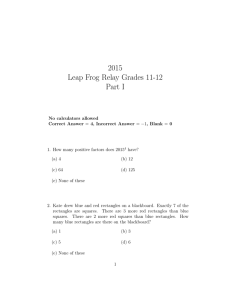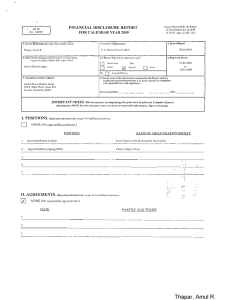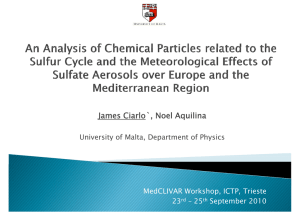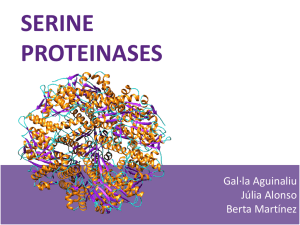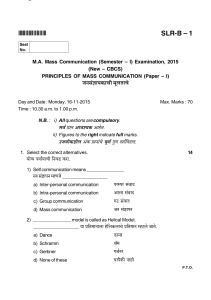Animal Phylum Summary Chart
advertisement
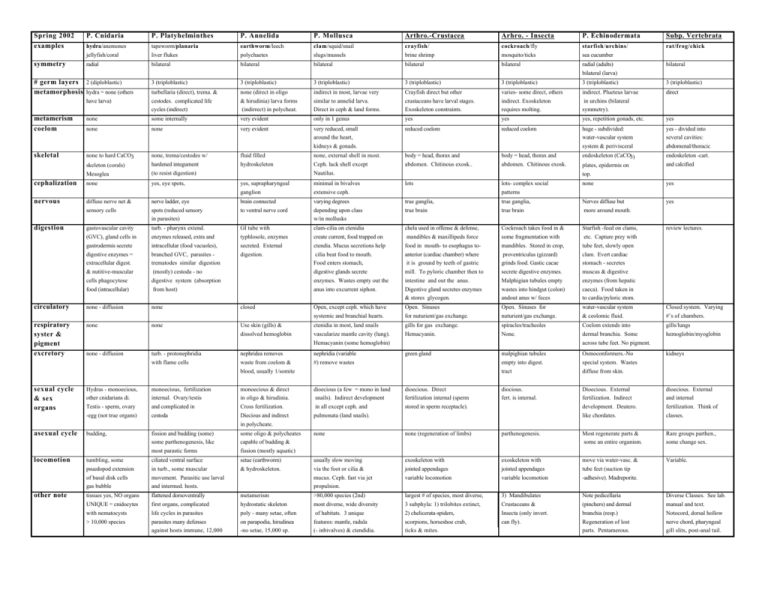
Spring 2002 examples P. Cnidaria P. Platyhelminthes P. Annelida P. Mollusca Arthro.-Crustacea Arhro. - Insecta P. Echinodermata Subp. Vertebrata hydra/anemones jellyfish/coral tapeworm/planaria liver flukes earthworm/leech polychaetes clam/squid/snail slugs/mussels crayfish/ brine shrimp cockroach/fly mosquito/ticks starfish/urchins/ sea cucumber rat/frog/chick symmetry radial bilateral bilateral bilateral bilateral bilateral radial (adults) bilateral (larva) bilateral 3 (triploblastic) 3 (triploblastic) 3 (triploblastic) 3 (triploblastic) 3 (triploblastic) 3 (triploblastic) 3 (triploblastic) none (direct in oligo & hirudinia) larva forms (indirrect) in polycheat. indirect in most, larvae very similar to annelid larva. Direct in ceph & land forms. Crayfish direct but other crustaceans have larval stages. Exoskeleton constraints. varies- some direct, others indirect. Exoskeleton requires molting. indirect. Plueteus larvae in urchins (bilateral symmetry). direct have larva) turbellaria (direct), trema. & cestodes. complicated life cycles (indirect) none some internally very evident only in 1 genus yes yes yes, repetition gonads, etc. yes none none very evident very reduced, small around the heart, kidneys & gonads. reduced coelom reduced coelom huge - subdivided: water-vascular system system & perivisceral yes - divided into several cavities: abdomenal/thoracic none to hard CaCO3 none, trema/cestodes w/ hardened integument (to resist digestion) fluid filled hydroskeleton none, external shell in most. Ceph. lack shell except Nautilus. body = head, thorax and abdomen. Chitinous exosk.. body = head, thorax and abdomen. Chitinous exosk. endoskeleton (CaCO3) skeleton (corals) Mesoglea endoskeleton -cart. and calcified cephalization none yes, eye spots, yes, suprapharyngeal ganglion minimal in bivalves extensive ceph. lots lots- complex social patterns none yes nervous diffuse nerve net & sensory cells nerve ladder, eye spots (reduced sensory in parasites) brain connected to ventral nerve cord varying degrees depending upon class w/in mollusks true ganglia, true brain true ganglia, true brain Nerves diffuse but more around mouth. yes digestion gastovascular cavity (GVC), gland cells in gastrodermis secrete digestive enzymes = extracellular digest. & nutitive-muscular cells phagocytose food (intracellular) turb. - pharynx extend. enzymes released, extra and intracellular (food vacuoles), branched GVC, parasites trematodes similar digestion (mostly) cestoda - no digestive system (absorption from host) GI tube with typhlosole, enzymes secreted. External digestion. clam-cilia on ctenidia create current, food trapped on ctendia. Mucus secretions help cilia beat food to mouth. Food enters stomach, digestive glands secrete enzymes. Wastes empty out the anus into excurrent siphon. chela used in offense & defense, mandibles & maxillipeds force food in mouth- to esophagus toanterior (cardiac chamber) where it is ground by teeth of gastric mill. To pyloric chamber then to intestine and out the anus. Digestive gland secretes enzymes & stores glycogen. Cockroach takes food in & some fragmentation with mandibles. Stored in crop, proventriculus (gizzard) grinds food. Gastic cacae secrete digestive enzymes. Malphigian tubules empty wastes into hindgut (colon) andout anus w/ feces Starfish -feed on clams, etc. Capture prey with tube feet, slowly open clam. Evert cardiac stomach - secretes muscus & digestive enzymes (from hepatic caeca). Food taken in to cardia/pyloric stom. review lectures. circulatory none - diffusion none closed Open, except ceph. which have systemic and branchial hearts. Open. Sinuses for nuturient/gas exchange. Open. Sinuses for nuturient/gas exchange. water-vascular system & ceolomic fluid. Closed system. Varying #’s of chambers. respiratory syster & pigment excretory none none Use skin (gills) & dissolved hemoglobin ctenidia in most, land snails vascularize mantle cavity (lung). Hemacyanin (some hemoglobin) gills for gas exchange. Hemacyanin. spiracles/tracheoles None. Coelom extends into dermal branchia. Some across tube feet. No pigment. gills/lungs hemoglobin/myoglobin none - diffusion turb. - protonephridia with flame cells nephridea removes waste from coelom & blood, usually 1/somite nephridia (variable #) remove wastes green gland malpighian tubules empty into digest. tract Osmoconformers.-No special system. Wastes diffuse from skin. kidneys sexual cycle & sex organs Hydras - monoecious, other cnidarians di. Testis - sperm, ovary -egg (not true organs) monoecious, fertilization internal. Ovary/testis and complicated in cestoda monoecious & direct in oligo & hirudinia. Cross fertilization. Diecious and indirect in polycheate. dioecious (a few = mono in land snails). Indirect development in all except ceph. and pulmonata (land snails). dioecious. Direct fertilization internal (sperm stored in sperm receptacle). diocious. fert. is internal. Dioecious. External fertilization. Indirect development. Deutero. like chordates. dioecious. External and internal fertilization. Think of classes. asexual cycle budding, fission and budding (some) some parthenogenesis, like most parastic forms some oligo & polycheates capable of budding & fission (mostly aquatic) none none (regeneration of limbs) parthenogenesis. Most regenerate parts & some an entire organism. Rare groups parthen., some change sex. locomotion tumbling, some psuedopod extension of basal disk cells gas bubble ciliated ventral surface in turb., some muscular movement. Parasitic use larval and intermed. hosts. setae (earthworm) & hydroskeleton. usually slow moving via the foot or cilia & mucus. Ceph. fast via jet propulsion. exoskeleton with jointed appendages variable locomotion exoskeleton with jointed appendages variable locomotion move via water-vasc. & tube feet (suction tip -adhesive). Madreporite. Variable. other note tissues yes, NO organs UNIQUE = cnidocytes with nematocysts > 10,000 species flattened dorsoventrally first organs, complicated life cycles in parasites parasites many defenses against hosts immune, 12,000 metamerism hydrostatic skeleton poly - many setae, often on parapodia, hirudinea -no setae, 15,000 sp. >80,000 species (2nd) most diverse, wide diversity of habitats. 3 unique features: mantle, radula (- inbivalves) & ctendidia. largest # of species, most diverse, 3 subphyla: 1) trilobites extinct, 2) chelicerata-spiders, scorpions, horseshoe crab, ticks & mites. 3) Mandibulates Crustaceans & Insecta (only invert. can fly). Note pedicellaria (pinchers) and dermal branchia (resp.) Regeneration of lost parts. Pentamerous. Diverse Classes. See lab. manual and text. Notocord, dorsal hollow nerve chord, pharyngeal gill slits, post-anal tail. # germ layers 2 (diploblastic) metamorphosis hydra = none (others metamerism coelom skeletal plates, epidermis on top.
